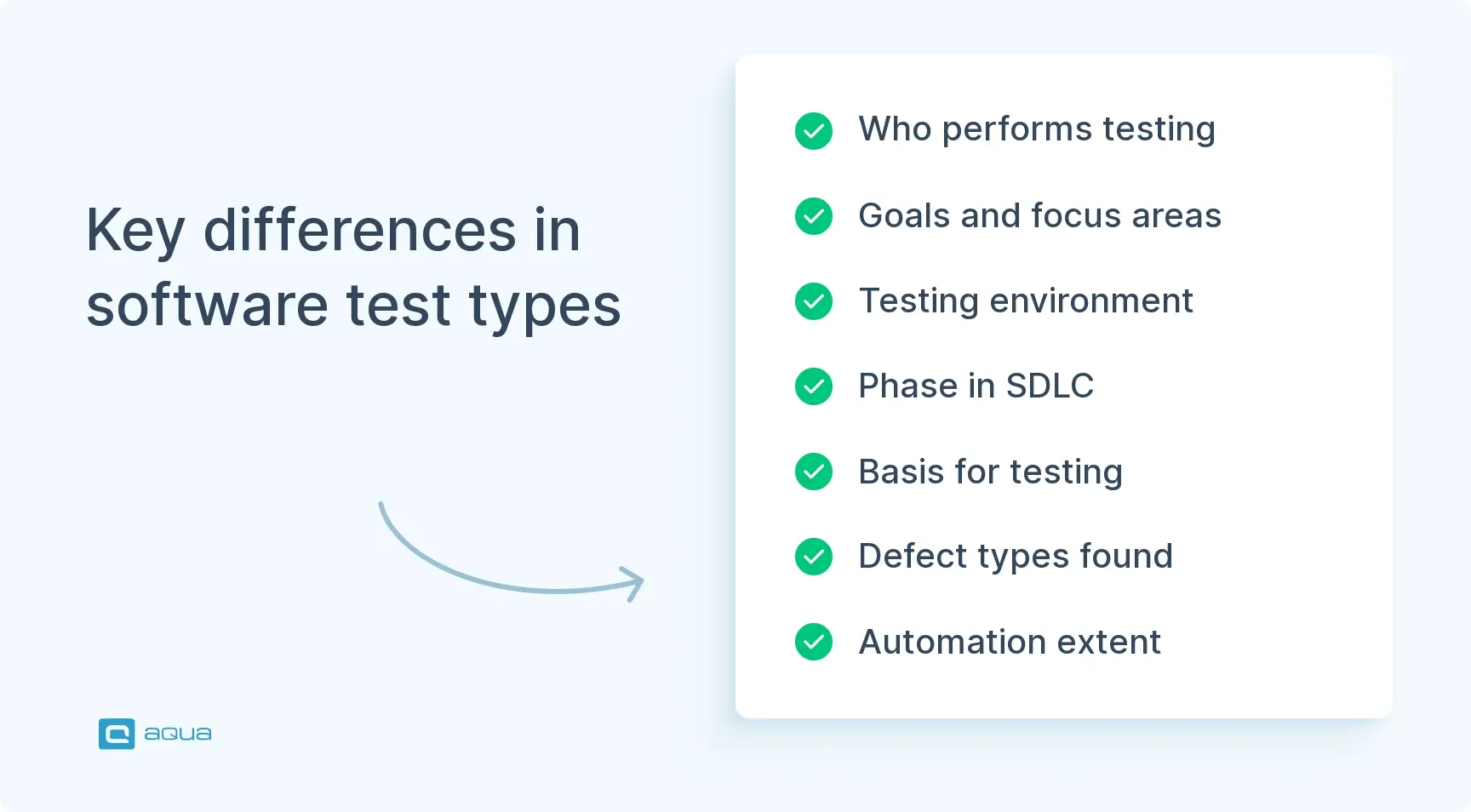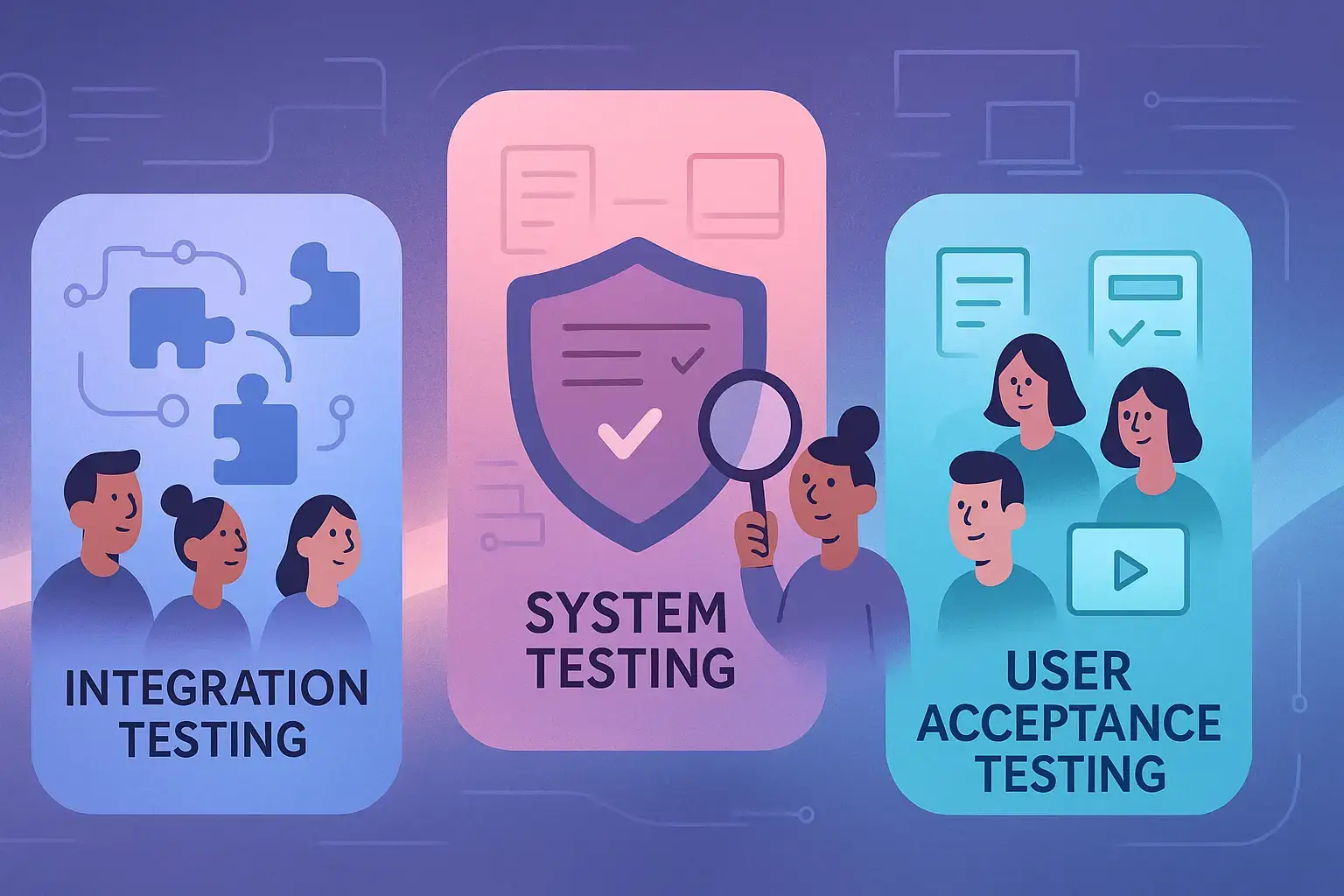Key Takeaways
- Integration Testing verifies that software components work together correctly, focusing on interfaces, data flow, and component interactions after unit testing but before system testing.
- System Testing evaluates the complete application as a unified whole, checking end-to-end functionality, performance, security, and compatibility in an environment similar to production.
- User Acceptance Testing (UAT) validates that real end users can accomplish their tasks with the software, focusing on business value rather than technical correctness.
- The three testing types serve complementary purposes, with integration testing catching component interaction bugs, system testing validating complete functionality, and UAT ensuring business value.
- A comprehensive testing strategy should incorporate all three testing types at appropriate development stages to catch different types of bugs before they reach production.
Knowing when to use each testing type can make the difference between software that technically works and software that delivers real business value. Discover how to implement these testing approaches effectively in your development cycle 👇
What is System Testing?
System testing puts your complete application through its paces as one unified whole. Instead of checking individual components, you’re testing the entire software package in an environment that mirrors production as closely as possible.
What System Testing Actually Covers
Functional testing verifies that all features work according to your specifications. Can users complete the workflows you designed?
Performance testing measures how your system handles real-world loads. Response times, throughput, and resource usage all get scrutinised under various conditions.
Security testing hunts for vulnerabilities that could expose user data or compromise system integrity.
Compatibility testing confirms your software works across different browsers, devices, and operating systems.
Recovery and stress testing push your system to its limits and beyond. How does it handle crashes? What happens when you throw more traffic at it than expected?
Who Does System Testing and Why
System testing gets handled by QA professionals who weren’t involved in building the software. Fresh eyes catch problems that developers might miss.
The approach is black-box testing, focusing on inputs and outputs from a user’s perspective. The goal is to find system-level problems that earlier testing phases missed. This includes integration issues between components, end-to-end functionality problems, and performance bottlenecks that only show up when everything runs together.
What is Integration Testing?
Integration Testing checks whether different parts of your application actually work together when you connect them. Your individual modules might pass their unit tests perfectly, but what happens when they try to talk to each other?
This is where integration testing comes in. It catches interface problems that only show up when separate components interact. Data gets corrupted during transfers. APIs don’t match what other services expect. Components make different assumptions about how interfaces should work.
How Teams Approach Integration Testing
Top-down integration starts with high-level modules and gradually adds lower-level components as testing progresses. You begin with the main application flow and work your way down to supporting modules.
Bottom-up integration does the opposite. Test individual modules first, then combine them into larger subsystems. This works well when you have stable low-level components but uncertain high-level behaviour.
Sandwich integration combines both approaches by testing core modules first, then integrating upward and downward simultaneously. Most complex applications benefit from this hybrid approach.
Big Bang integration throws all components together at once and tests them as a complete unit. Risky for large systems, but sometimes necessary for tightly coupled applications.
What Integration Testing Actually Validates
Integration testing happens after unit testing but before system testing. Developers or test engineers who understand system architecture typically handle this work because you need to know how components are supposed to interact.
The focus areas include verifying that data passed between modules gets processed correctly, ensuring APIs match what other services expect, and checking that database interactions work properly across different modules. You also test message queues, event-driven communications, and error handling across component boundaries.
Integration testing doesn’t comprehensively test each component. That’s what unit tests do. Instead, it confirms components work together as designed and identifies problems like mismatched interfaces, improper data transformations, or timing issues that only occur during component interaction.
The key difference from system testing is scope. Integration testing focuses on how pieces fit together. System testing evaluates whether the complete application delivers what users need.
Having the right tool to manage these different approaches can make all the difference. aqua cloud’s comprehensive test management platform seamlessly handles all these testing phases in one unified solution. With features like end-to-end traceability linking requirements to test cases across all testing levels, your team can ensure nothing falls through the cracks. The platform’s AI-powered test case generation helps you create thorough test scenarios for each testing type in seconds, whether you’re verifying component interactions in integration testing, validating system-wide functionality, or facilitating user acceptance. aqua’s collaborative workflows and real-time reporting provide transparency between technical teams and business stakeholders, bridging the gap that often exists between system testing and UAT phases. Integrations like Jira, Confluence, and Azure DevOps will help you supercharge your toolkit, enhancing it with modern QA management in 2025 that gets your job done in a few clicks.
Reduce testing complexity and improve coverage across all testing phases with aqua
What is User Acceptance Testing (UAT)?
User Acceptance Testing (UAT) is where actual end users test your software to see if it actually helps them do their jobs. This isn’t about technical correctness anymore. It’s about whether real people can accomplish real tasks using your application.
UAT happens when your software is technically complete but needs validation from the people who will actually use it. Instead of professional testers checking against specifications, you have actual users performing their daily workflows to see if the system supports how they work.
How UAT Actually Works
UAT takes place in an environment that resembles production as closely as possible. You use real-world scenarios based on business requirements, not technical test cases. The people doing the testing are actual end users or representatives from client organizations who understand the business context.
The process includes defining acceptance criteria that clearly outline what makes the software acceptable from a business perspective. Users create test scripts that reflect their common scenarios, use realistic test data, and document any problems they encounter.
UAT typically happens after system testing and bug fixes are complete. It serves as the final gate before production deployment, giving stakeholders confidence that the system will work in real conditions.
What Makes UAT Different
Unlike technical testing phases, UAT success often depends on user satisfaction rather than strict technical measurements. The question being answered is whether the system helps users accomplish their goals effectively.
This is subjective territory. Users might find that a technically perfect feature doesn’t fit their workflow, or discover that the system creates more work instead of simplifying their tasks. These insights only come from people who understand the business context and daily operational realities.
UAT gives users a chance to become familiar with the software before the official launch, while also serving as risk mitigation. You want to ensure the software delivers business value before investing in full deployment across the organisation.
The key difference from system testing is perspective. System testing verifies technical requirements against specifications. UAT validates business requirements from the user’s point of view.
Key Differences Between UAT, System Testing, and Integration Testing
Understanding the distinct characteristics of each testing type helps teams apply them effectively. Here’s a comprehensive comparison:
| Aspect | Integration Testing | System Testing | User Acceptance Testing |
|---|---|---|---|
| Purpose | Verify that components work together correctly | Evaluate if the complete system meets specifications | Validate that the system fulfills business needs |
| Performed by | Developers or technical testers | QA professionals | End-users or client representatives |
| Testing environment | Development or integration environment | Test environment that mimics production | Staging environment that closely resembles production |
| Timing in SDLC | After unit testing, before system testing | After integration testing, before UAT | Final testing phase before production deployment |
| Test focus | Interfaces between components, data flow | End-to-end functionality, performance, security | Business processes and workflows |
| Test basis | Technical design specifications, API contracts | System requirements, technical specifications | User requirements, business processes |
| Test approach | Both white-box and black-box | Primarily black-box | Black-box |
| Types of defects found | Interface issues, data transfer problems | System-level bugs, performance issues, security vulnerabilities | Usability problems, business logic errors, workflow gaps |
| Test data | Fabricated test data | Mix of fabricated and production-like data | Real-world data |
| Automation potential | High – can be extensively automated | Medium – some aspects can be automated | Low – requires human judgment |
| Success criteria | Technical requirements satisfaction | System requirements compliance | User satisfaction and business needs fulfillment |
While they share the common goal of improving software quality, they approach it from different angles and with different priorities. But when and how you should use each one? That we cover in the next section.

When to Use Each Testing Type
Timing matters in testing. Use the wrong approach at the wrong time, and you waste effort while missing critical bugs. Here’s when each type delivers the most value.
Integration Testing Use Cases
Integration testing shines when components need to work together but haven’t been tested in combination yet. Use it when adding new modules or third-party services, after major refactoring that affects component interactions, or when building microservices that need to communicate.
Key scenarios include:
- Multiple teams building different components that need to work together
- Heavy database interaction across different modules
- Message queues or event-driven architectures where timing matters
- Mixed technology stacks where different languages or frameworks interact
You’ll also want integration testing in continuous integration pipelines, running after unit tests but before system-level validation.
System Testing Use Cases
System testing validates that your complete application works as intended. Use it before major releases, after development milestones, or when infrastructure changes that could affect overall behavior.
This approach becomes critical for:
- Complex workflows that span multiple modules and user interactions
- Performance-sensitive applications where system-level behavior matters
- Security-critical systems that need comprehensive validation
- Applications with numerous external integrations that could fail in combination
Run system testing when you need confidence that everything works together under realistic conditions.
UAT Use Cases
UAT happens when your software is technically ready but needs business validation. Use it before final production deployment, after significant UI changes, or when implementing features that directly impact how users work.
UAT becomes particularly important for:
- High-visibility applications where user satisfaction matters for adoption
- Complex business processes that technical testing might miss
- Revenue-impacting systems where user experience affects business outcomes
- Regulated environments where compliance requires user validation
This testing answers whether your software actually helps people do their jobs better.
Using Them Together
These testing types complement each other rather than compete. Integration testing catches component interaction bugs. System testing validates complete functionality. UAT ensures business value. A solid testing strategy uses all three at appropriate development stages.
The relationship between system integration testing and user acceptance testing is complementary. System integration focuses on technical component integration, while UAT validates business functionality from the user’s perspective.
Conclusion
Understanding when to use Integration Testing, System Testing, and UAT makes the difference between shipping software that works and shipping software that works well. Integration testing catches component problems, System testing validates complete functionality, and UAT ensures real users can actually accomplish their goals. Use all three strategically throughout development with robust QA strategies, and you’ll catch different types of bugs before they frustrate users or damage your reputation. The goal isn’t proving your software works perfectly, but finding and fixing problems while they’re still cheap to resolve.
As we’ve explored the distinct purposes of UAT, System Testing, and Integration Testing, it’s clear that a structured approach to managing these testing types is essential for software quality. This is where aqua cloud excels: providing a unified platform that supports your entire testing lifecycle. With aqua, you can maintain clear separation between testing phases while ensuring seamless information flow between them. The platform’s AI Copilot assists in generating comprehensive test cases tailored to each testing type, while powerful integrations with tools like Jira and Confluence keep everyone aligned. Teams using aqua report up to 97% time savings in test case creation and management across all testing phases. The platform’s dashboards provide real-time visibility into testing progress, helping you identify gaps in coverage, whether you’re conducting technical system tests or business-oriented UAT. By centralising your testing activities in aqua, you eliminate the silos that typically separate these crucial testing phases.
Transform your testing approach with a unified platform that handles all testing phases with ease


















